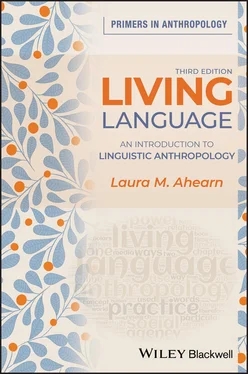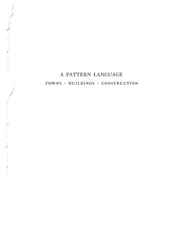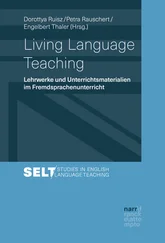Living Language
An Introduction to Linguistic Anthropology
Third Edition
Laura M. Ahearn

This edition first published 2021
© 2021 John Wiley & Sons Ltd.
Edition History
Second Edition © 2017 John Wiley & Sons Ltd.
First Edition © 2012 John Wiley & Sons Ltd.
All rights reserved. No part of this publication may be reproduced, stored in a retrieval system, or transmitted, in any form or by any means, electronic, mechanical, photocopying, recording or otherwise, except as permitted by law. Advice on how to obtain permission to reuse material from this title is available at http://www.wiley.com/go/permissions.
The right of Laura M. Ahearn to be identified as the author of this work has been asserted inaccordance with law.
Registered Offices
John Wiley & Sons, Inc., 111 River Street, Hoboken, NJ 07030, USA
John Wiley & Sons Ltd, The Atrium, Southern Gate, Chichester, West Sussex, PO19 8SQ, UK
Editorial Office
9600 Garsington Road, Oxford, OX4 2DQ, UK
For details of our global editorial offices, customer services, and more information about Wiley products visit us at www.wiley.com.
Wiley also publishes its books in a variety of electronic formats and by print-on-demand. Some content that appears in standard print versions of this book may not be available in other formats.
Limit of Liability/Disclaimer of Warranty
The contents of this work are intended to further general scientific research, understanding, and discussion only and are not intended and should not be relied upon as recommending or promoting scientific method, diagnosis, or treatment by physicians for any particular patient. In view of ongoing research, equipment modifications, changes in governmental regulations, and the constant flow of information relating to the use of medicines, equipment, and devices, the reader is urged to review and evaluate the information provided in the package insert or instructions for each medicine, equipment, or device for, among other things, any changes in the instructions or indication of usage and for added warnings and precautions. While the publisher and authors have used their best efforts in preparing this work, they make no representations or warranties with respect to the accuracy or completeness of the contents of this work and specifically disclaim all warranties, including without limitation any implied warranties of merchantability or fitness for a particular purpose. No warranty may be created or extended by sales representatives, written sales materials or promotional statements for this work. The fact that an organization, website, or product is referred to in this work as a citation and/or potential source of further information does not mean that the publisher and authors endorse the information or services the organization, website, or product may provide or recommendations it may make. This work is sold with the understanding that the publisher is not engaged in rendering professional services. The advice and strategies contained herein may not be suitable for your situation. You should consult with a specialist where appropriate. Further, readers should be aware that websites listed in this work may have changed or disappeared between when this work was written and when it is read. Neither the publisher nor authors shall be liable for any loss of profit or any other commercial damages, including but not limited to special, incidental, consequential, or other damages.
Library of Congress Cataloging-in-Publication Data
Names: Ahearn, Laura M., 1962- author.
Title: Living language : an introduction to linguistic anthropology / Laura M. Ahearn.
Description: Third edition. | Hoboken, NJ : John Wiley & Sons, 2021. | Includes bibliographical references and index.
Identifiers: LCCN 2020037410 (print) | LCCN 2020037411 (ebook) | ISBN 9781119608141 (paperback) | ISBN 9781119608196 (pdf) | ISBN 9781119608158 (epub)
Subjects: LCSH: Anthropological linguistics. | Language and culture.
Classification: LCC P35 .A38 2021 (print) | LCC P35 (ebook) | DDC 306.44—dc23
LC record available at https://lccn.loc.gov/2020037410
LC ebook record available at https://lccn.loc.gov/2020037411
Cover image: © pworld /Getty Images
Cover design by Wiley
Set in 11.5/13.5 BemboStd by Integra Software Service, Pondicherry, India
1 Cover
2 Title page Living Language An Introduction to Linguistic Anthropology Third Edition Laura M. Ahearn
3 Copyright
4 Table of Contents
5 List of Figures
6 List of Tables
7 Preface
8 Acknowledgments
9 Part I Language: Some Basic Questions1 The Socially Charged Life of LanguageSo, What Do You Need to Know in Order to “Know” a Language?Examples of Linguistic DiversityExamples of Diversity in Research Topics in Linguistic AnthropologyKeith BassoMarjorie Harness GoodwinBonnie UrciuoliAlessandro DurantiKathryn A. WoolardJames M. WilceKey Terms in Linguistic AnthropologyMultifunctionalityLanguage IdeologiesPracticeIndexicalityThe Inseparability of Language, Culture, and Social Relations2 Gestures, Sign Languages, and MultimodalityBakhtin’s Double-Voiced DiscourseGoffman’s Participation Framework and Production FormatSpeech and the Analysis of ConversationGestures and Other Forms of Embodied CommunicationSign LanguagesPoetry, Whistled Languages, Song, and Images3 The Research Process in Linguistic AnthropologyWhat Kinds of Research Questions Do Linguistic Anthropologists Formulate?What Kinds of Data Do Linguistic Anthropologists Collect, and with What Methods?Participant ObservationInterviewsSurveys and QuestionnairesNaturally Occurring ConversationsExperimental MethodsMatched Guise TestsWritten TextsHow Do Linguistic Anthropologists Analyze Their Data?What Products Do Linguistic Anthropologists Generate from their Research?What Sorts of Ethical Issues Do Linguistic Anthropologists Face?4 Language Acquisition and SocializationLanguage Acquisition and the Socialization ProcessGaps in the “Language Gap” ApproachLanguage Socialization in Bilingual or Multilingual ContextsLanguage Socialization throughout the LifespanConclusion5 Language, Thought, and CultureA Hundred Years of Linguistic RelativityThe Sapir–Whorf HypothesisInvestigating the Effects of Language on ThoughtLanguage-in-GeneralLinguistic StructuresColorSpaceTimeLanguage UseConclusion
10 Part II Global Communities of Speakers, Hearers, Readers, and Writers6 Global Communities of Multilingual Language UsersDefining “Speech Community”Size and Location of the CommunityWhat Is Shared by the Members of a Speech Community?The Type of Interactions that Speech Community Members HaveAlternatives to the Concept of “Speech Community”Speech AreasSpeech NetworksCommunities of PracticeMultilingual and Transnational Linguistic PracticesDiglossia, Code-Mixing, and Code-SwitchingDiglossiaCode-SwitchingCode-MixingHeteroglossiaConclusion7 Literacy PracticesLiteracy Events vs. Literacy Practices“Autonomous” vs. “Ideological” Approaches to Studying LiteracySome Examples of Situated Literacy ResearchPreschool Literacy Practices in the Southeastern United StatesPema Kumari’s letterLove-letter Writing in NepalInstant Messaging: More like Speech or Writing?8 Online Communities and Internet Linguistic PracticesOnline Literacy PracticesCapitalization, Punctuation, and EmojisOnline Communities, Relationships, and Social MediaWho’s Zoomin’ Who?Online AvatarsSo Close and yet so FarConclusion9 Performance, Performativity, and the Constitution of CommunitiesPerformance Defined in Opposition to CompetencePerformativityPerformance as a Display of Verbal ArtistryEthnographies of Performance and Performativity
Читать дальше













